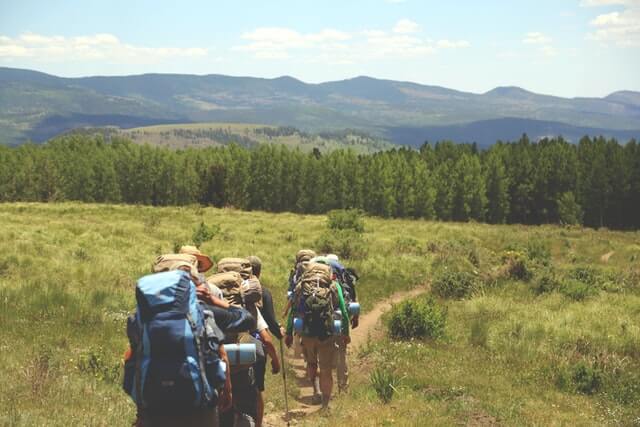Many people enjoy recreational hiking because it provides them with an opportunity to walk as much as they want and improve their health. However, hiking is not only walking, the process is more complicated than you might think. In this article we are going to show you why is hiking such a complete lower body workout.
You are going to get familiar with the basic techniques and we will show you why so many people chose hiking as their primary fitness routine. If you are interested in both hiking and performing lower body workouts, stay tuned in!
Lower Body Muscles That Get Engaged with Hiking
Probably the greatest benefit of hiking is that you improve the muscles in your lower body. Even though this activity is not considered and classified as sport, it still has many perks not only for the lower but the whole body. Just like with any other exercise, you should start slowly so as to not strain yourself. Do not go alone if you are not experienced but bring a hiker or go with a hiking group in case something goes wrong.
First start hiking on flat surfaces as a warm up and then gradually after some time, when you realize that you are in need of a bigger physical exertion, go for uneven terrains and hills. After some time you can even consider adding weights to your backpack or legs in order to step up the game.
Must read: Which Exercises Help Prepare For Uphill Hiking? Your Guide To Blazing Trail
However, make sure to remember that should happen gradually over time – otherwise you might injure yourself seriously, and you do not want a sprain or pain in your muscles somewhere in the middle of wilderness.
Glutes
Hiking can do wonders for your glutes, but in order for that to happen you will have to add weight to your workout. Start with small weight and then gradually increase it over time. It would be easy to just put it inside your backpack while you hike.
It is possible for hiking to replace your whole cardio exercise; however, you will need to adjust your walking a bit. This also depends on the type of terrain you are hiking on. For example, if you are hiking on flat surfaces without any weight, your glutes won’t be affected much. However, hiking on uneven surface is amazing for your glutes, even without weights. To learn more continue reading!
Quadriceps
Quadriceps are the muscles above your knee that will be most engaged when you decide to get off the hill. If your body is not prepared for this, you will feel the soreness for sure. People with strong and exercised muscles tend to easily overcome such obstacles so make sure to avoid any pain.
In order to avoid and prevent it, you need to prepare your body for hiking. Do not just venture into a couple of days long hiking trip if you have not been walking regularly before that. Additionally, if you also carry a heavy load your muscles will be strained even more and you might collapse.
Therefore make sure to do either some short hikes or workouts at home before you go on a big trip. Warm up your muscles and prepare them for the long walks. They will need it.
Calves
Calves are mostly associated with mountaineering, but you can shape them by hiking as well. Just like with glutes, it depends on the weight and terrain. If you always carry a heavy backpack then your calves with definitely be engaged more during walking.
If the load is not heavy enough, try adding weights inside. However, before you even decide on hiking, try some tests at home in order to see just how strong your calves are:
- Find a small block to step on.
- Step on the block with your toes while the heels are in the air.
- Support the whole weight of your body with your toes.
- Now try dropping down your heels as much as possible until you feel that your calves are stretched enough.
- If you are able to do at least 3 sets of 20 repetitions – your calves are in good condition. If not, then they need more warm ups and exercising.
It might even happen that one calf is stronger than the other and that is fine. In that case just try to engage the weaker one more.
Hamstrings
The hamstrings are the main thigh muscles that get engaged a lot while hiking. The stronger your hamstrings are, the heavier the load you would be able to carry. Depending on the terrain, you might engage your hamstrings more than you think you would.
Perform a good research beforehand on a type of terrain you plan to cover. For example, if you are going hiking somewhere where the train is extremely soft, then your heels will sink in and the pressure on hamstrings will increase. Make sure to prepare this muscle by warming up and doing short walks or exercises at home. Even when you walk be careful to step carefully and correctly, because you can injure this muscle by moving in a wrong way.
A chair walk is a great exercise for hamstrings and a perfect warm up before the hike:
- Take a chair.
- Sit on it normally.
- Now try walking around the room while sitting on the chair.
- This exercise can strengthen your hamstrings.
Lower Back
If you are interested in improving your lower back muscles, then hiking can really make a difference. Carrying around a heavy backpack can cause an extreme pressure on your lower back thus put you in pain.
If you are not careful and ignore the pain you might even cause an injury to that part of your body. That is why your lower back should always be in shape for hiking. In order to achieve this, take short hikes, walks or trips before you venture into the big hiking adventure. Start with small loads and then gradually increase the weight.
Try out some abdominal exercises that might lower the chances of you injuring your back. In order to have a firm posture you have to make sure that the core of your body is strengthened. Let’s take a look at some additional exercises:
Squats are a great way to improve your thighs, hips and core.
- Put your feet width apart with your hips and stand tall.
- Now make sure that your heels are on ground and slowly lower your hips back.
- The knees should stay behind your toes and they should never be over them.
- Make sure to lower as much as your body allows you, if you feel pain then stand up otherwise your back should always be straight.
- Now stand back to your first position.
- Try to repeat this exercise at least 20 times in 3 sets.
- If you want to step up your game, then put your arms in line with your ears while you perform the squats. This would strengthen your core.
Stationary lunges do wonders for your hips, thighs and core.
- Make a staggered stance but stand tall.
- The front foot should be flat while your back heel is raised while you hold your weight between the front flat foot and the back raised foot.
- Now slowly lower your body while keeping the straight stance. The weight should be held evenly balanced in the same position while you lower it too.
- The front knee should never go past your toes.
- Try to repeat this exercise for 25 repetitions in at least 3 sets.
- Do not forget to do same with the other leg.
Step ups are great for the glute and thighs.
- Stand tall with your back straight while facing a platform or chair that is at least 6 inches tall.
- Put your right foot onto this platform and make sure to squeeze your butt as much as you can while transferring your whole weight to your right leg.
- Now stand and put your left foot on the platform while raising the right leg.
- Now lower back to the original position.
- Try to repeat this exercise for 25 repetitions in at least one set. Do not forget to switch the sides.
Tap downs are the perfect exercises for your hips, knees and ankles.
- Find a low platform of at least 2 inches and stand on it.
- Now place your hands on your hips.
- Try to slowly lower your right heel towards the ground while keeping your hips in parallel with knees. It would be great if you would be able to look at your position in the mirror.
- Strengthen your left leg and raise back up while repetition this exercise for 8 to 15 repetitions. Do at least 3 sets and you will feel your hips burning.
A high box step up is a great and challenging exercise that would ensure you do not face injuries while hiking. If you perform it properly, you will enjoy and benefit more from your hiking. It targets your glutes, quads and hamstrings.
- Put one foot on a platform that is slightly higher than your knees.
- Now move forward with your whole body in order to press hamstring and stretch it.
- Then you should lift your other leg and lift yourself up so you are standing with the first foot on this platform.
- Get back to the same position.
- Repeat this exercise for at least 10 repetitions and you will see that it is harder than it seems. Do not forget to reverse the sides.
Thighs
Hikers usually engage their outer thighs when walking downhill. People usually lean back when they walk downhill which even more increases the pressure on thighs. However, this is the safest position for a person to walk on a declined surface.
However, if your thigh muscles are not strong enough to handle this pressure, then your hips will hurt and you will feel the pain there later. This means that even your thighs should be prepared for the upcoming trip.
When it comes to inner thighs, they are under pressure when you are off the trail. This means that when you walk on the uneven surfaces such as rocks, mud and so on, your inner thighs will feel the pressure and they will be engaged during every movement.
See also: Ankle Strengthening: Steps to Improve the Strength and Stability of Your Ankle
The best exercise for strengthening inner thighs includes side hops. Find and place two towels on the floor and in such a way as to not reach them when you spread your legs. Then hop from one towel to the other by jumping from one leg, spreading the other etc. You should do at least 3 sets with as many repetitions as you can handle.
However, do not use weights while hopping. If you do, you might injure your ankles and knees. If you do decide to go for weights, then reduce the distance between the towels and move from one to the other in a side squat position, which is much safer.
Final Thoughts
To sum up, we have talked about the importance of strengthening your body before hiking. Hiking is an amazing activity that can improve your health and the lower body balance. There are many ways to achieve this but you have to be prepared beforehand.
As we already said, make sure to be physically trained before you go on a big hike in the wilderness. Do not exert yourself otherwise you might injure some parts of the body. Go slowly and gradually increase the weight of your backpack and the distance. If you do it properly, soon you will notice the difference. For more tips on training for your backpacking trip, see our article for information.
Featured Image Source: https://unsplash.com/photos/juHayWuaaoQ








